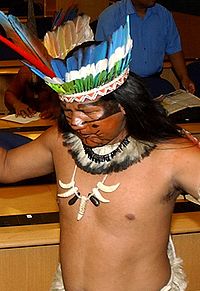- Munduruku people
-
Mundurucu 
Total population 11,630 (2010)[1] Regions with significant populations Brazil (Amazonas, Mato Grosso, Pará)[1] Languages The Munduruku (Mundurucu or Wuy Jugu) are an indigenous people of Brazil living in the Amazon River basin. Some Mundurucu communities are part of the Coatá-Laranjal Indigenous Land.[2] They had an estimated population in 2010 of 11,640.[1]
Contents
History
Traditionally the Munduruku's territory, called Mundurukânia in the 19th century, was the Tapajós River valley.[1] In 1788, they completely defeated their ancient enemies the Muras. After 1803 they lived at peace with the Brazilians.[citation needed]
Today the tribe faces threats to their homelands from hydroelectric projects, illegal gold-panning, and a new waterway construction on the Tapajós River.[1]
Name
Also known as the Mundurucu, Maytapu, and Cara Preta, the Mundurucu's name for themselves is Wuy Jugu. Oral history says the name "Muduruku" comes from their enemies the Parintintin people and means "red ants," based on the historical Munduruku tactic of attacking en masse.[2]
Culture
The Mundurucu have a distinctive residence pattern. Rather than a pattern based on conjugal or affinal bonds, in the Munduruku villages, all males over the age of thirteen live in one household, and all of the females live with all of the males under thirteen in another.[citation needed]
Language
 Munduruku Indians, painted by Hercules Florence
Munduruku Indians, painted by Hercules Florence
The Munduruku language is part of the Tupi language family.[2]
They are also notable for their linguistic separation of "us" (their tribe) from "them" (everyone else), the pariwat. Whereas they refer to themselves as the wuujuyû, or "our people", everyone else is spoken of as the equivalent of "prey".[citation needed]
Unlike the Pirahã, the Mundurucu have a numeracy system, albeit limited (similar to that found in some Aboriginal Australian cultures). Pierre Pica was instrumental (in a work done in collaboration with Stanislas Dehaene and Elizabeth Spelke) in revealing the psychophysics and linguistic properties of the Munduruku counting system to the Western world. The Mundurucu only have number words up to five, although each word is not as definite in meaning as number words in English. Furthermore, the Mundurucu use the logarithmic scale to approximate number "distance", which is a strategy all humans have been shown to use before more extensive exposure in numbers.[citation needed]
Notes
External links
- "Cognition and arithmetics capability : what the Mundurucus Indians can teach us", CNRS Press relesae October,2004
- Amazon Children "Spontaneously" Understand Geometry National Geographic News, January 2006
- "Mastering the Geometry of the Jungle", New York Times, June 24, 2006
- "Intuitions of number-space in Amazonian Idigenous groups" CEA Press release, June 2008.
- Pica, P & Lecomte, A (2008), "Theoretical implications of the study of Numbers and Numerals in Mundurucu," Philosophical Psychology 21.4
- Pica, P, C Lemer, V Izard & Dehaene, S. (2004), "Exact and approximate arithmetic in an Amazonian Indigene Group" Science, 306, pp. 499–503.
- Dehaene, S., Izard, V., Spelke, E & Pica, P (2008), "Log or linear Distinct Intuitions of the number scale in Western and Amazonian Indigene Culture" Science 320, 5880, 1217–20
Categories:- Indigenous peoples in Brazil
- Indigenous peoples of the Amazon
Wikimedia Foundation. 2010.
